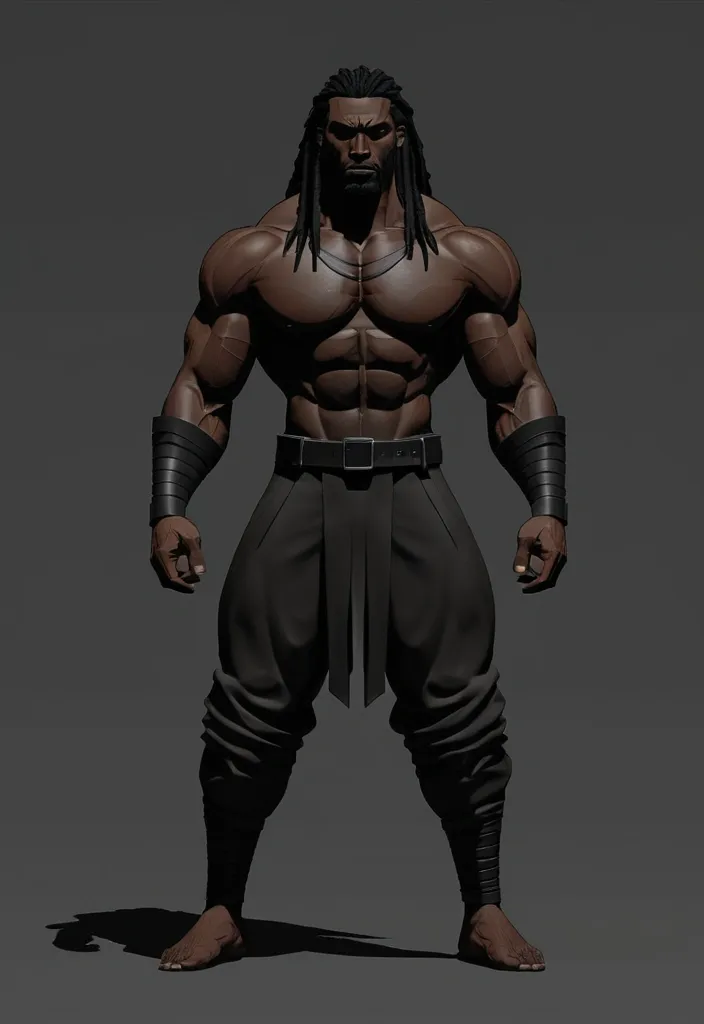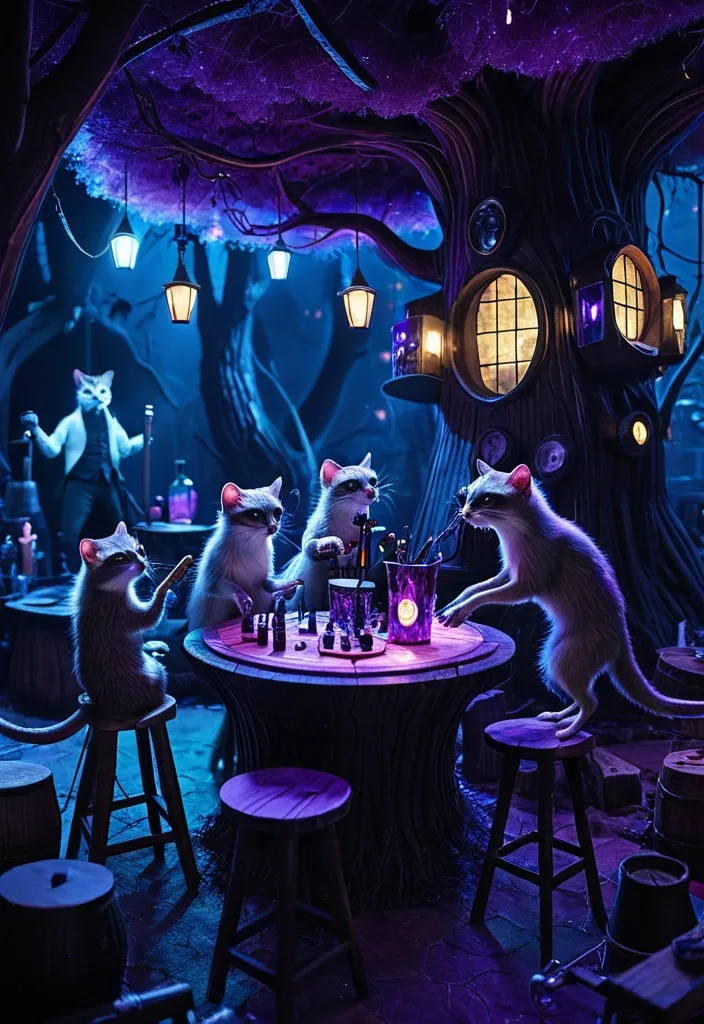Search Results for Strong
Explore AI generated designs, images, art and prompts by top community artists and designers.

20s ish human monk His eyes Are Green iridescent , like a June bug. Dark long eyelashes and a natural winged eyeliner His hair is a soft golden honey brown with heavy wavy locks that he keeps cut currently into a Mohawk. His skin is a dark olive Mediterranean tone. 6’2” , 175 , very trim but pronounced muscles like an Olympic swimmer. Even though he has striking features like a strong jawline and high cheek bones , He wears silk monk robes in the burnt orange with blue with floral burnt orange silk liner that shows on his lapel , collar , arm holes , and leggings. He wears a yellow silk belt with a wood beaded rope that is actually a whip , pouches , and ordimental jewelry of his monastery and from his family; such as earrings , necklaces , bracelets , ankle bracelets , and rings ,

A tall , powerful 6'8" male anthropomorphic bear stands upright with a serious , obedient expression. His body is heavily built in a Bara-style form: wide chest , thick arms , strong legs , and dense muscular definition. His fur is a smooth blend of deep green and silver , transitioning naturally across his torso , arms , and legs. His head features a sharp , backward-swept red mohawk resembling a solid flame shape , paired with a matching red goatee beard cut neatly along the jawline. His eyes glow bright green with narrow yellow pupils , focused forward with calm intensity. He wears simple brown shorts and a pair of tall yellow old fisherman rubber boots. The boots are fully rubber , slightly scuffed and worn , with thick soles and oversized circular bulging toe sections that look heavy and rounded. Their height reaches well up his lower legs , and the rubber surface shows a smooth sheen with clear dimensional shape. ,

A team of municipal staff from the Concello de Dodro inside a retro-futuristic control room , filled with metallic panels , soft neon lights , and holographic displays showing schematics of an artificial intelligence system. The staff wear retro-futuristic municipal attire while analyzing glowing graphs , floating data patterns , and digital circuits. The environment blends vintage sci-fi technology with advanced elements: illuminated tubes , analog switches , curved screens , and holograms. Cinematic lighting , blue and amber tones , hyper-realistic textures , and a strong sense of focus and collaboration as they try to understand how the AI works in an alternative future. ,

A hyperrealistic 8K ultra-high-definition cinematic photograph of a vast , bustling , and highly efficient modern logistics center. The scene is alive with dynamic activity: numerous forklifts and automated guided vehicles (AGVs) smoothly navigate across the polished concrete floor , transporting pallets stacked high with a diverse range of goods. Long , intricate conveyor belts run overhead and at floor level , moving packages rapidly through various sorting and packing stations. Towering , multi-tiered shelving units extend majestically towards the high ceiling , neatly organized with inventory , creating an imposing sense of scale. In the mid-ground , workers in bright safety vests are actively engaged in their tasks: some meticulously sorting packages , others scanning barcodes with handheld devices , and operating control panels. Automated robotic arms precisely pick and place items from shelves , demonstrating technological prowess. Overhead , drones might be seen performing inventory scans , adding a subtle futuristic touch to the advanced warehouse operation. The lighting is a sophisticated mix of bright industrial LED lights illuminating the vast space and natural daylight streaming in through large skylights and expansive windows , creating areas of sharp focus , realistic reflections on the floor , and subtle , dramatic shadows. Dust motes are faintly visible dancing in the strong beams of light , adding to the gritty realism and active atmosphere. The overall composition conveys organized chaos , precision , and continuous motion , vividly capturing the essence of modern supply chain operations at its peak efficiency. ,

A hyperrealistic , 8K ultra-high-definition , cinematic portrait of an unimaginably beautiful Hispanic woman , focusing on her upper body. Her ethereal beauty transcends earthly realism , embodying both pure innocence and profound , captivating sensuality , making her seem almost divine. Facial Features: Her flawless Hispanic face possesses perfectly symmetrical , delicate yet strong contours. Her eyes are large , captivating blue , crystal-clear , and intensely expressive , holding a mysterious , serene gaze that radiates both ancient wisdom and untouched innocence. They sparkle with an otherworldly luminescence , drawing the viewer into their depth. Her lips are full , naturally rosy , and subtly curved into a gentle , enigmatic smile that conveys both purity and a soft , alluring charm. Her nose and cheekbones reflect classic Hispanic elegance , rendered with breathtaking detail. Hair: Long , luxurious , dark hair (e.g. , rich , glossy black or deep , wavy brown with subtle reddish undertones typical of Hispanic features) cascades softly over her shoulders and upper back. It subtly glows or shimmers with an ethereal light , as if kissed by moonlight or starlight , creating a delicate , magical halo effect around her head. The texture is incredibly detailed , showing individual strands yet maintaining a soft , dreamlike quality. Skin Tone & Texture: Her skin is utterly flawless , impossibly smooth , and possesses a radiant , sun-kissed luminosity that appears to emit a soft , pearlescent glow , characteristic of exquisite Hispanic complexions. Every pore , subtle blush , and minute detail is rendered with photorealistic precision , yet it retains a dreamlike , almost translucent quality that hints at her fantastical origin. Attire & Form: She wears an elegant , flowing garment made of ethereal , perhaps shimmering , silk or a translucent , delicate fabric that drapes softly over her shoulders and décolletage. The attire subtly enhances her graceful silhouette without overt exposure , embodying refined sensuality. The fabric might gently glow or reflect soft , muted colors. Her posture is serene and elegant , exuding innate grace and a quiet power. Lighting & Atmosphere: Bathed in soft , diffused , magical lighting that originates from an unseen , fantastical source (e.g. , gentle starlight filtering through clouds , the soft glow of an enchanted forest , or an otherworldly aurora borealis). This sublime lighting sculpts her features perfectly , casting delicate , artistic shadows that emphasize her otherworldly beauty. The background is minimalistic and softly blurred , composed of swirling , luminous colors or faint , indistinct fantastical elements (e.g. , distant , soft cosmic dust , abstract light patterns) , ensuring the primary focus remains entirely on her captivating and impossibly beautiful presence. The overall atmosphere is one of profound serenity , divine grace , and wondrous fantasy , akin to seeing a living masterpiece from an ancient myth. ,

Hyperrealistic 8k photorealistic portrait of a mature woman standing on a sunlit Balinese veranda at golden hour , oval face , almond-shaped dark brown eyes , small flat rounded nose , high cheekbones , full lips , warm bronze skin , long unkempt black hair falling in loose waves over her shoulders , adult woman , confident strong posture , slight forward tilt , gaze meeting the viewer with serene intensity , three-quarter body shot from mid-thigh up , medium wide-angle lens , shallow depth of field , bokeh from distant tropical foliage. Clothing: white linen button-down tank top with wide shoulder straps , snug fit around the torso with light bust shaping , top two buttons left unfastened to reveal modest , natural cleavage while remaining fully clothed , fabric texture visible with fine weave and subtle creases , waist wrapped in an authentic batik sarong with deep indigo and maroon parang motifs tied in a traditional style , no head covering , culturally authentic Indonesian styling. Physique: curvaceous and voluptuous yet athletic , toned abs and defined obliques visible under the linen , sculpted feminine muscles , prominent collarbones , visible ribcage contours and taut abdomen suggesting regular physical discipline , healthy vibrant skin with subtle sheen , faint visible veins along forearms , confident grounded stance. Setting details: carved teak pillars , woven bamboo screens , a low incense smoke haze drifting in warm breeze , palm fronds casting delicate dappled shadows , distant volcanic silhouette and calm sea reflecting sunset , scattered frangipani blossoms on the veranda floor. Lighting: cinematic chiaroscuro with warm golden rim light from behind , soft warm key light from camera-left illuminating face and torso , cool fill from right creating gentle contrast , volumetric shafts of light and subtle rim highlights on hair and shoulder , specular highlights on linen and skin. Color palette: warm bronze and saffron , deep indigo and maroon batik accents , soft creamy whites , tropical greens , muted ocean blues , cinematic teal-orange grading. Composition and framing: vertically oriented medium full-body composition , subject placed on right third , eyes on upper third , slight negative space to left showing veranda and seascape , low camera angle for empowering presence , subtle Dutch tilt for dynamic tension. Artistic style and techniques: ultra-detailed hyperrealism with painterly filmic mood , textures emphasized—skin pores , fine hair strands , linen weave , batik thread details—soft cinematic grain , inspired by high-end fashion photography and contemporary portrait painters , delicate Art Nouveau line influences in the drape of fabric , rendered with Octane Render and photoreal shaders , volumetric lighting , gentle filmic bloom , ethereal serene atmosphere , glowing iridescent highlights on jewelry and wet wood , ultra-detailed finishing , post-processed color grading for depth and warmth. ,

Initial Focus & Quality Leads MASTERPIECE , Ultra-Fine Fantasy Photography , Ethereal Liquid Art , Hyperrealistic , 16K , 1 subject. Core Subject Concept & Identity A female spirit , embodying ethereal beauty and fluid grace , with a body composed of translucent , emanating light. Action , Pose & Interaction Emerging majestically from the turbulent water of a large waterfall. Her pose is graceful and dynamic , conveying a sense of mystical ascent. Her gaze is serene and otherworldly. Body & Form Details Her body is entirely fluid and translucent , appearing almost liquid , with light visibly emanating from within her form. She possesses delicate feminine proportions. Attire & Styling Detail She wears a long , flowing translucent dress that is also bioluminescent , glowing softly with an inner light that complements the light from her body. The fabric of the dress appears to ripple like water itself. Her long , ethereal hair (also possibly translucent or glowing) flows dynamically with her movement and the water. Lighting , Atmosphere & Render Style The scene is powerfully illuminated by a strong backlit effect , causing her translucent body and dress to glow intensely against the darker , dramatic backdrop of the waterfall. The atmosphere is mystical , awe-inspiring , and profoundly ethereal , emphasizing her otherworldly nature. Rendered with liquid precision , luminous depth , and ethereal grace. Background & Environmental Elements The background is dominated by a large , powerful waterfall , from which she is directly emerging. The water is dynamic , misty , and reflective , enhancing the dramatic lighting and the sense of her origin. Camera , Lens & Technicals Captured on a high-resolution professional camera (e.g. , Canon EOS R5) with a 70-200mm f/2.8 L lens. Aperture f/4.0 to ensure sharp focus on the spirit while allowing the grandeur of the waterfall to be visible. Composition is a medium full shot , emphasizing her elegant form against the powerful water. Post-production for extreme clarity , enhancing the translucent and bioluminescent effects , emphasizing the backlit glow , and capturing minute details of fluid motion and light. Quality Modifiers & Score Unparalleled detail , Zena Holloway/Paolo Roversi blend aesthetic , fluid translucent body , feminine form , light emanating , emerging from water , large waterfall , long bioluminescent dress , long hair , backlit effect , high quality , very detailed , ethereal , mystical , Score_9 , 16K. ,

STYLE: Flat Action Fantasy (Simplified) — bold clean outlines , large shadow blocks , smooth shapes , minimal texture , simplified anatomy , strong silhouette. Aidan is a tall , powerful Black man with dark skin. His body is athletic but simplified: fewer muscle lines , cleaner shapes , and broad silhouette. He has long dark dreadlocks drawn in large , unified strands rather than many small ones. His wolf-like eyes are sharp but simple , no glow unless total darkness. Clothes: dark sleeveless top , simple pants , thick belt. Arm bracers are minimal , with no excessive detail. No small straps , no extra folds. Overall look: imposing , clean , animation-ready. ,

A colossal octopus emerges from stormy seas , its massive tentacles wrapping around crumbling skyscrapers as a tsunami engulfs a coastal metropolis. The scene is chaotic , with cars overturned , debris flying through the air , and survivors desperately seeking higher ground. Dramatic lightning strikes illuminate the dark , ominous sky , casting high contrast shadows that amplify the tension. The cinematic disaster movie aesthetic is evident in the hyper-realistic details , with strong atmospheric effects like dust , fog , and explosions adding to the apocalyptic atmosphere. The focus of the lighting contrasts the despair of the destruction with the hope of survival , creating an intense and epic visual narrative reminiscent of blockbuster disaster films. ,

Create a hyper-realistic portrait of the beautiful man from the reference photo , presented inside an oversized Instagram post frame that dominates the scene. His facial features remain identical to the reference—delicate yet sharp , clean , and naturally stunning. He stands in a modern , slightly dynamic pose: upper body leaning subtly forward as if engaging directly with the viewer , one hand casually gripping the top edge of the Instagram frame , while one leg steps gracefully outward through the frame , creating a smooth and stylish 3D illusion. The pose should feel youthful , fresh , effortlessly elegant , and confidently cool. Give his a high-fashion model expression—eyes locked on the viewer with calm , magnetic intensity , lips softly relaxed and neutral , jawline softly defined , and an overall vibe that is composed , serene , and highly photogenic. No smile or smirk; just a strong , clean , modern editorial gaze with subtle freshness and quiet power. He wears a light mint ribbed knit sweater , high-waisted straight-fit white trousers , and sleek jeans , creating a crisp , refreshing , cool-toned outfit that feels luxurious yet approachable. The Instagram frame is ultra-realistic with: • username “Mahesh Babu” • verified badge • display name “AI Generation” • caption “Ai King AICreation GoogleGeminiPrompts” • authentic Instagram UI icons (like , comment , share , save) • a circular profile picture identical to the reference photo of his. The background features a fresh modern gradient of mint blending seamlessly into soft teal , with airy highlights and subtle smooth textures that perfectly complement the cool-toned outfit. Clean cinematic lighting accentuates the structure of her face , the soft knit texture , and the 3D breakout effect , resulting in a bright , modern , viral-ready editorial portrait. ,

Create a hyper-realistic portrait of the beautiful man from the reference photo , presented inside an oversized Instagram post frame that dominates the scene. His facial features remain identical to the reference—delicate yet sharp , clean , and naturally stunning. He stands in a modern , slightly dynamic pose: upper body leaning subtly forward as if engaging directly with the viewer , one hand casually gripping the top edge of the Instagram frame , while one leg steps gracefully outward through the frame , creating a smooth and stylish 3D illusion. The pose should feel youthful , fresh , effortlessly elegant , and confidently cool. Give his a high-fashion model expression—eyes locked on the viewer with calm , magnetic intensity , lips softly relaxed and neutral , jawline softly defined , and an overall vibe that is composed , serene , and highly photogenic. No smile or smirk; just a strong , clean , modern editorial gaze with subtle freshness and quiet power. He wears a light mint ribbed knit sweater , high-waisted straight-fit white trousers , and sleek jeans , creating a crisp , refreshing , cool-toned outfit that feels luxurious yet approachable. The Instagram frame is ultra-realistic with: • username “Mahesh babu” • verified badge • display name “AI Generation” • caption “Ai Queen AICreation GoogleGeminiPrompts” • authentic Instagram UI icons (like , comment , share , save) • a circular profile picture identical to the reference photo of her. The background features a fresh modern gradient of mint blending seamlessly into soft teal , with airy highlights and subtle smooth textures that perfectly complement the cool-toned outfit. Clean cinematic lighting accentuates the structure of her face , the soft knit texture , and the 3D breakout effect , resulting in a bright , modern , viral-ready editorial portrait. ,

A family of stoats diligently operating a tiny , makeshift Dance bar hidden within a giant tree hollow , broadcasting musical signals into the night. young cat wears a makeshift tutu and dance , tables-chair , Musical instrument , and wine bottles are scattered around their miniature bar. cinematic fantasy atmosphere with deep blues and blacks contrasted by vivid electric purples and magentas. Glowing highlights , misty volumetric light , and glossy , high-detail textures. Balanced compositions with a strong central focus , dark surroundings , and saturated luminous accents that create an intense , magical mood. ,

https://arthub.ai/post/ff4afd23-635e-42d2-81da-01c7865701ed Style: Illustrations combining comic books , graphic novels , and sequential art. Utilize vibrant and dynamic colors , with attention to framing and composition to create a sense of movement and action. Incorporate graphic design elements , such as stylized speech bubbles (optional) and subtle visual onomatopoeia to enhance the impact of the scene. Maintain a sense of realism and depth , with attention to detail and character anatomy. The lighting should be dramatic and expressive , creating an immersive and emotional atmosphere. , Aidan: Strong , elegant , imposing werewolf alpha , 25-35 years old (each era) , dark skin , dreads , lupine eyes. Powerful , determined. , Slender , graceful vampire , 25-35 years old (each era) , dark skin , long dark dreads , captivating eyes. Mysterious , beautiful. , 1: First Encounter (1905): Vienna ball , "spark" first glance. Liaandra (stunning dress) , Aidan (imposing). Vibrant colors , focus on characters , blurred background. Details: Ballroom , dresses , eye contact , bokeh. Colors: Reds , golds , whites , sapphire. ,

https://arthub.ai/post/ff4afd23-635e-42d2-81da-01c7865701ed Style: Illustrations combining comic books , graphic novels , and sequential art. Utilize vibrant and dynamic colors , with attention to framing and composition to create a sense of movement and action. Incorporate graphic design elements , such as stylized speech bubbles (optional) and subtle visual onomatopoeia to enhance the impact of the scene. Maintain a sense of realism and depth , with attention to detail and character anatomy. The lighting should be dramatic and expressive , creating an immersive and emotional atmosphere. , Aidan: Strong , elegant , imposing werewolf alpha , 25-35 years old (each era) , dark skin , dreads , lupine eyes. Powerful , determined. , Slender , graceful vampire , 25-35 years old (each era) , dark skin , long dark dreads , captivating eyes. Mysterious , beautiful. , 1: First Encounter (1905): Vienna ball , "spark" first glance. Liaandra (stunning dress) , Aidan (imposing). Vibrant colors , focus on characters , blurred background. Details: Ballroom , dresses , eye contact , bokeh. Colors: Reds , golds , whites , sapphire. ,

https://arthub.ai/post/ff4afd23-635e-42d2-81da-01c7865701ed Style: Illustrations combining comic books , graphic novels , and sequential art. Utilize vibrant and dynamic colors , with attention to framing and composition to create a sense of movement and action. Incorporate graphic design elements , such as stylized speech bubbles (optional) and subtle visual onomatopoeia to enhance the impact of the scene. Maintain a sense of realism and depth , with attention to detail and character anatomy. The lighting should be dramatic and expressive , creating an immersive and emotional atmosphere. , Aidan: Strong , elegant , imposing werewolf alpha , 25-35 years old (each era) , dark skin , dreads , lupine eyes. Powerful , determined. , Slender , graceful vampire , 25-35 years old (each era) , dark skin , long dark dreads , captivating eyes. Mysterious , beautiful. , 1: First Encounter (1905): Vienna ball , "spark" first glance. Liaandra (stunning dress) , Aidan (imposing). Vibrant colors , focus on characters , blurred background. Details: Ballroom , dresses , eye contact , bokeh. Colors: Reds , golds , whites , sapphire. ,

https://arthub.ai/post/ff4afd23-635e-42d2-81da-01c7865701ed Style: Illustrations combining comic books , graphic novels , and sequential art. Utilize vibrant and dynamic colors , with attention to framing and composition to create a sense of movement and action. Incorporate graphic design elements , such as stylized speech bubbles (optional) and subtle visual onomatopoeia to enhance the impact of the scene. Maintain a sense of realism and depth , with attention to detail and character anatomy. The lighting should be dramatic and expressive , creating an immersive and emotional atmosphere. , Aidan: Strong , elegant , imposing werewolf alpha , 25-35 years old (each era) , dark skin , dreads , lupine eyes. Powerful , determined. , Slender , graceful vampire , 25-35 years old (each era) , dark skin , long dark dreads , captivating eyes. Mysterious , beautiful. , 3: The Letter (1912): Aidan writes. Emotion , intensity. Close-up face , letter/pen. Dramatic lighting. Details: Face , letter , pen , expression. Colors: Sepia , browns , crimson , candle. Details: Garden , roses , whispers. Colors: Blues , purples , greens , moonlight. ,

https://arthub.ai/post/ff4afd23-635e-42d2-81da-01c7865701ed Style: Illustrations combining comic books , graphic novels , and sequential art. Utilize vibrant and dynamic colors , with attention to framing and composition to create a sense of movement and action. Incorporate graphic design elements , such as stylized speech bubbles (optional) and subtle visual onomatopoeia to enhance the impact of the scene. Maintain a sense of realism and depth , with attention to detail and character anatomy. The lighting should be dramatic and expressive , creating an immersive and emotional atmosphere. , Aidan: Strong , elegant , imposing werewolf alpha , 25-35 years old (each era) , dark skin , dreads , lupine eyes. Powerful , determined. , Slender , graceful vampire , 25-35 years old (each era) , dark skin , long dark dreads , captivating eyes. Mysterious , beautiful. , 3: The Letter (1912): Aidan writes. Emotion , intensity. Close-up face , letter/pen. Dramatic lighting. Details: Face , letter , pen , expression. Colors: Sepia , browns , crimson , candle. Details: Garden , roses , whispers. Colors: Blues , purples , greens , moonlight. ,

https://arthub.ai/post/ff4afd23-635e-42d2-81da-01c7865701ed Style: Illustrations combining comic books , graphic novels , and sequential art. Utilize vibrant and dynamic colors , with attention to framing and composition to create a sense of movement and action. Incorporate graphic design elements , such as stylized speech bubbles (optional) and subtle visual onomatopoeia to enhance the impact of the scene. Maintain a sense of realism and depth , with attention to detail and character anatomy. The lighting should be dramatic and expressive , creating an immersive and emotional atmosphere. , Aidan: Strong , elegant , imposing werewolf alpha , 25-35 years old (each era) , dark skin , dreads , lupine eyes. Powerful , determined. , Slender , graceful vampire , 25-35 years old (each era) , dark skin , long dark dreads , captivating eyes. Mysterious , beautiful. , 3: The Letter (1912): Aidan writes. Emotion , intensity. Close-up face , letter/pen. Dramatic lighting. Details: Face , letter , pen , expression. Colors: Sepia , browns , crimson , candle. Details: Garden , roses , whispers. Colors: Blues , purples , greens , moonlight. ,

https://arthub.ai/post/ff4afd23-635e-42d2-81da-01c7865701ed Style: Illustrations combining comic books , graphic novels , and sequential art. Utilize vibrant and dynamic colors , with attention to framing and composition to create a sense of movement and action. Incorporate graphic design elements , such as stylized speech bubbles (optional) and subtle visual onomatopoeia to enhance the impact of the scene. Maintain a sense of realism and depth , with attention to detail and character anatomy. The lighting should be dramatic and expressive , creating an immersive and emotional atmosphere. , Aidan: Strong , elegant , imposing werewolf alpha , 25-35 years old (each era) , dark skin , dreads , lupine eyes. Powerful , determined. , Slender , graceful vampire , 25-35 years old (each era) , dark skin , long dark dreads , captivating eyes. Mysterious , beautiful. , 2: Secret Garden (1910): Moonlight garden , intimacy. Liaandra/Aidan whisper. Composition: faces in focus , roses blurred. Details: Garden , roses , whispers. Colors: Blues , purples , greens , moonlight. ,

https://arthub.ai/post/ff4afd23-635e-42d2-81da-01c7865701ed Style: Illustrations combining comic books , graphic novels , and sequential art. Utilize vibrant and dynamic colors , with attention to framing and composition to create a sense of movement and action. Incorporate graphic design elements , such as stylized speech bubbles (optional) and subtle visual onomatopoeia to enhance the impact of the scene. Maintain a sense of realism and depth , with attention to detail and character anatomy. The lighting should be dramatic and expressive , creating an immersive and emotional atmosphere. , Aidan: Strong , elegant , imposing werewolf alpha , 25-35 years old (each era) , dark skin , dreads , lupine eyes. Powerful , determined. , Slender , graceful vampire , 25-35 years old (each era) , dark skin , long dark dreads , captivating eyes. Mysterious , beautiful. , 2: Secret Garden (1910): Moonlight garden , intimacy. Liaandra/Aidan whisper. Composition: faces in focus , roses blurred. Details: Garden , roses , whispers. Colors: Blues , purples , greens , moonlight. ,

https://arthub.ai/post/ff4afd23-635e-42d2-81da-01c7865701ed Style: Illustrations combining comic books , graphic novels , and sequential art. Utilize vibrant and dynamic colors , with attention to framing and composition to create a sense of movement and action. Incorporate graphic design elements , such as stylized speech bubbles (optional) and subtle visual onomatopoeia to enhance the impact of the scene. Maintain a sense of realism and depth , with attention to detail and character anatomy. The lighting should be dramatic and expressive , creating an immersive and emotional atmosphere. , Aidan: Strong , elegant , imposing werewolf alpha , 25-35 years old (each era) , dark skin , dreads , lupine eyes. Powerful , determined. , Slender , graceful vampire , 25-35 years old (each era) , dark skin , long dark dreads , captivating eyes. Mysterious , beautiful. , 2: Secret Garden (1910): Moonlight garden , intimacy. Liaandra/Aidan whisper. Composition: faces in focus , roses blurred. Details: Garden , roses , whispers. Colors: Blues , purples , greens , moonlight. ,

3: The Letter (1912): Aidan writes a passionate love letter to Liaandra in his dimly lit study. Focus on the intensity of his emotions and the weight of his words. Use strong shadows and warm candlelight to create a sense of intimacy and longing. Details: Intimate study , quill and ink , candlelight , heartfelt letter , intense emotions. Color Palette: Warm browns , deep reds , and soft yellows , with strong shadows. ,

3: The Letter (1912): Aidan writes a passionate love letter to Liaandra in his dimly lit study. Focus on the intensity of his emotions and the weight of his words. Use strong shadows and warm candlelight to create a sense of intimacy and longing. Details: Intimate study , quill and ink , candlelight , heartfelt letter , intense emotions. Color Palette: Warm browns , deep reds , and soft yellows , with strong shadows. ,

Style: Evocative and painterly illustrations , inspired by concept art and cinematic stills. Focus on capturing emotion and atmosphere. The images should feel like key moments from a music video or a dramatic film. Emphasis on lighting , color , and composition to tell the story visually. Avoid heavy outlines and sharp comic book details. Think more "impressionistic" and less "literal." , Character Descriptions (Apply to all scenes): Aidan: A strong , elegant , and imposing werewolf alpha , appearing in his late 20s to early 30s in each era , with dark skin , dreadlocks , and piercing eyes with a wolf-like coloration. His gaze is intense and unwavering , conveying a sense of inner strength and protectiveness. Liaandra: A slender , elegant , and graceful vampire , appearing in her late 20s to early 30s in each era , with dark skin , long dark dreadlocks , and striking eyes with a captivating allure and a subtle reddish hue. She carries herself with quiet confidence and sophistication , hinting at a timeless beauty and hidden depths. , 2: Secret Garden (1910): Aidan and Liaandra share a secret rendezvous in a moonlit garden. Focus on the intimacy and vulnerability of the moment. They whisper promises under the stars , their faces illuminated by the soft moonlight. Details: Moonlit garden , blooming roses , whispered secrets , intimate atmosphere. Color Palette: Deep blues , purples , and greens , with silver moonlight highlighting their faces. ,

3: The Letter (1912): Aidan writes a passionate love letter to Liaandra in his dimly lit study. Focus on the intensity of his emotions and the weight of his words. Use strong shadows and warm candlelight to create a sense of intimacy and longing. Details: Intimate study , quill and ink , candlelight , heartfelt letter , intense emotions. Color Palette: Warm browns , deep reds , and soft yellows , with strong shadows. ,

Style: Evocative and painterly illustrations , inspired by concept art and cinematic stills. Focus on capturing emotion and atmosphere. The images should feel like key moments from a music video or a dramatic film. Emphasis on lighting , color , and composition to tell the story visually. Avoid heavy outlines and sharp comic book details. Think more "impressionistic" and less "literal." , Character Descriptions (Apply to all scenes): Aidan: A strong , elegant , and imposing werewolf alpha , appearing in his late 20s to early 30s in each era , with dark skin , dreadlocks , and piercing eyes with a wolf-like coloration. His gaze is intense and unwavering , conveying a sense of inner strength and protectiveness. Liaandra: A slender , elegant , and graceful vampire , appearing in her late 20s to early 30s in each era , with dark skin , long dark dreadlocks , and striking eyes with a captivating allure and a subtle reddish hue. She carries herself with quiet confidence and sophistication , hinting at a timeless beauty and hidden depths. , 2: Secret Garden (1910): Aidan and Liaandra share a secret rendezvous in a moonlit garden. Focus on the intimacy and vulnerability of the moment. They whisper promises under the stars , their faces illuminated by the soft moonlight. Details: Moonlit garden , blooming roses , whispered secrets , intimate atmosphere. Color Palette: Deep blues , purples , and greens , with silver moonlight highlighting their faces. ,

Style: Evocative and painterly illustrations , inspired by concept art and cinematic stills. Focus on capturing emotion and atmosphere. The images should feel like key moments from a music video or a dramatic film. Emphasis on lighting , color , and composition to tell the story visually. Avoid heavy outlines and sharp comic book details. Think more "impressionistic" and less "literal." , Character Descriptions (Apply to all scenes): Aidan: A strong , elegant , and imposing werewolf alpha , appearing in his late 20s to early 30s in each era , with dark skin , dreadlocks , and piercing eyes with a wolf-like coloration. His gaze is intense and unwavering , conveying a sense of inner strength and protectiveness. Liaandra: A slender , elegant , and graceful vampire , appearing in her late 20s to early 30s in each era , with dark skin , long dark dreadlocks , and striking eyes with a captivating allure and a subtle reddish hue. She carries herself with quiet confidence and sophistication , hinting at a timeless beauty and hidden depths. , 1: First Encounter (1905): Aidan and Liaandra's eyes meet across a crowded ballroom in Vienna. Focus on the subtle connection and unspoken attraction. Liaandra is radiant in her gown , and Aidan is struck by her beauty. Use soft , warm lighting to create a romantic atmosphere. Details: Opulent ballroom , elegant gowns , soft lighting , subtle expressions. Color Palette: Warm golds , deep reds , creamy whites , with a touch of amber. ,

Style: Evocative and painterly illustrations , inspired by concept art and cinematic stills. Focus on capturing emotion and atmosphere. The images should feel like key moments from a music video or a dramatic film. Emphasis on lighting , color , and composition to tell the story visually. Avoid heavy outlines and sharp comic book details. Think more "impressionistic" and less "literal." , Character Descriptions (Apply to all scenes): Aidan: A strong , elegant , and imposing werewolf alpha , appearing in his late 20s to early 30s in each era , with dark skin , dreadlocks , and piercing eyes with a wolf-like coloration. His gaze is intense and unwavering , conveying a sense of inner strength and protectiveness. Liaandra: A slender , elegant , and graceful vampire , appearing in her late 20s to early 30s in each era , with dark skin , long dark dreadlocks , and striking eyes with a captivating allure and a subtle reddish hue. She carries herself with quiet confidence and sophistication , hinting at a timeless beauty and hidden depths. , 2: Secret Garden (1910): Aidan and Liaandra share a secret rendezvous in a moonlit garden. Focus on the intimacy and vulnerability of the moment. They whisper promises under the stars , their faces illuminated by the soft moonlight. Details: Moonlit garden , blooming roses , whispered secrets , intimate atmosphere. Color Palette: Deep blues , purples , and greens , with silver moonlight highlighting their faces. ,

Style: Evocative and painterly illustrations , inspired by concept art and cinematic stills. Focus on capturing emotion and atmosphere. The images should feel like key moments from a music video or a dramatic film. Emphasis on lighting , color , and composition to tell the story visually. Avoid heavy outlines and sharp comic book details. Think more "impressionistic" and less "literal." , Character Descriptions (Apply to all scenes): Aidan: A strong , elegant , and imposing werewolf alpha , appearing in his late 20s to early 30s in each era , with dark skin , dreadlocks , and piercing eyes with a wolf-like coloration. His gaze is intense and unwavering , conveying a sense of inner strength and protectiveness. Liaandra: A slender , elegant , and graceful vampire , appearing in her late 20s to early 30s in each era , with dark skin , long dark dreadlocks , and striking eyes with a captivating allure and a subtle reddish hue. She carries herself with quiet confidence and sophistication , hinting at a timeless beauty and hidden depths. , 1: First Encounter (1905): Aidan and Liaandra's eyes meet across a crowded ballroom in Vienna. Focus on the subtle connection and unspoken attraction. Liaandra is radiant in her gown , and Aidan is struck by her beauty. Use soft , warm lighting to create a romantic atmosphere. Details: Opulent ballroom , elegant gowns , soft lighting , subtle expressions. Color Palette: Warm golds , deep reds , creamy whites , with a touch of amber. ,

Style: Evocative and painterly illustrations , inspired by concept art and cinematic stills. Focus on capturing emotion and atmosphere. The images should feel like key moments from a music video or a dramatic film. Emphasis on lighting , color , and composition to tell the story visually. Avoid heavy outlines and sharp comic book details. Think more "impressionistic" and less "literal." , Character Descriptions (Apply to all scenes): Aidan: A strong , elegant , and imposing werewolf alpha , appearing in his late 20s to early 30s in each era , with dark skin , dreadlocks , and piercing eyes with a wolf-like coloration. His gaze is intense and unwavering , conveying a sense of inner strength and protectiveness. Liaandra: A slender , elegant , and graceful vampire , appearing in her late 20s to early 30s in each era , with dark skin , long dark dreadlocks , and striking eyes with a captivating allure and a subtle reddish hue. She carries herself with quiet confidence and sophistication , hinting at a timeless beauty and hidden depths. , 1: First Encounter (1905): Aidan and Liaandra's eyes meet across a crowded ballroom in Vienna. Focus on the subtle connection and unspoken attraction. Liaandra is radiant in her gown , and Aidan is struck by her beauty. Use soft , warm lighting to create a romantic atmosphere. Details: Opulent ballroom , elegant gowns , soft lighting , subtle expressions. Color Palette: Warm golds , deep reds , creamy whites , with a touch of amber. ,